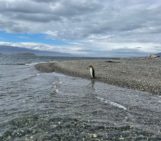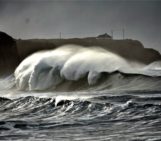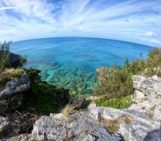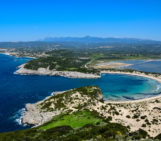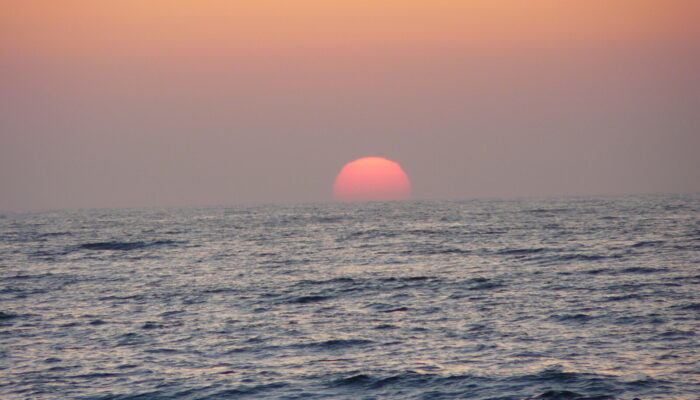
When runoff from farmland and urban areas enters our streams and rivers, it carries a heavy load of fertilizers and nutrients. These substances accumulate and flow into our coastal oceans, triggering a series of reactions that can create hypoxic ‘dead zones’. Dead zones are low-oxygen, or hypoxic, areas in the world’s oceans and lakes. Because most organisms need oxygen to live, very few organisms can survive in hypoxic conditions. These zones are areas on the sea floor where oxygen levels are depleted to the point that they can no longer support marine life. In this blog post, I want you to join me in learning about how these dead zones affect maritime life, but also what humans can do for marine conservation.
Unless you’re a creature like H. Salminicola or Phylum Loricifera, you need oxygen to survive regardless of whether your habitat is land, water, or both. The richness of ocean ecosystems, supported by biogeochemical cycles, relies heavily on oxygen. However, a significant concern has emerged: the ocean is experiencing insufficient oxygen levels, leading to a chronic condition known as hypoxia. Consequently, there are many dead zones forming around the world, which is threatening our oceans’ biodiversity.
What is ocean hypoxia and how does it occur?
The definition of hypoxia is the condition of not having enough oxygen in a substance, such as water or blood. For oceans, the National Ocean Service (USA) defines it as “[…] water conditions where the concentration of oxygen is so low that it is detrimental to organisms and very few organisms can survive in those conditions.”
This phenomenon is like a metabolic meltdown in the sea’s bustling ecosystem. It happens when excess nutrients from agricultural runoff, industrial pollutants, overfishing, and sewage flow into coastal waters and cause an algae feeding frenzy. These algae, fueled by nitrogen and phosphorus, end up blooming into massive gatherings. During the day, they provide oxygen through photosynthesis, but when night falls or the blooms inevitably crash, their decomposition sucks up oxygen like a vacuum cleaner! This speedy oxygen consumption creates hypoxic conditions where bacteria feast on the fallen algae and lower oxygen levels even more, hence the formation of ‘dead zones’. These zones, as a result, become aquatic ghost towns, which are a threat to ocean biodiversity, fisheries, and the health of our underwater world.
What are examples of areas affected by ocean hypoxia?
The gulf of Mexico, the Chesapeake Bay in the United States, and the Gulf of Thailand are a few examples of areas that are currently suffering from dead zones. The Baltic Sea alone, for instance, is home to seven of the world’s 10 largest marine dead zones.

Hypoxia, a worldwide problem: Areas of Anthropogenically-Influenced Estuarine and Coastal Hypoxia Worldwide. Image source: https://gulfhypoxia.net/about-hypoxia/
What are the types of dead zones?
There are four main types of dead zones: permanent, temporary, seasonal, and diel-cycling.
Permanent Dead Zones
Permanent dead zones are found in deep water where oxygen levels are consistently low year-round. Dissolved oxygen in these areas typically remains below 2 milligrams per liter, creating a harsh environment for most marine organisms. These zones are stable and do not vary significantly with seasonal or daily changes.
Temporary Dead Zones
Temporary dead zones experience hypoxic conditions for short periods, usually lasting only hours or days. These zones can form due to sudden environmental changes, such as a spike in nutrient runoff following a storm. The brief duration of these dead zones means they can quickly return to normal oxygen levels once the contributing factors subside.
Seasonal Dead Zones
Seasonal dead zones, the most common type like the Gulf of Mexico’s dead zone, typically form once a year. These zones often develop during warmer months when increased temperatures and rainfall lead to nutrient runoff into water bodies. The excess nutrients cause algal blooms, which deplete oxygen levels when they decompose. Seasonal dead zones can last for weeks to months and usually dissipate as conditions change, such as cooler temperatures in the fall.
Diel-Cycling Dead Zones
Diel-cycling dead zones fluctuate daily. These zones experience hypoxic conditions during specific times of the day, often influenced by the natural rhythms of photosynthesis and respiration in aquatic plants and microorganisms. For example, oxygen levels might drop at night when photosynthesis stops and respiration continues, then rise again during daylight hours.
Do dead zones have a chance to recover?
The encouraging news is that ocean dead zones have the potential to recover. Hypoxic waters in areas such as the Black Sea, the Hudson River, and San Francisco Bay are among the few that have begun to show signs of improvement. Addressing the root causes, such as agricultural runoff, is essential and can restore these oxygen-depleted areas to their former healthy ecosystems.
However, in some regions, agricultural chemicals have accumulated over time, causing extensive damage and making the recovery process slow and arduous. For example, a 2018 study suggests that even if no additional nitrogen were to enter the Mississippi River Basin, the existing nitrogen pollution would cause eutrophication in the Gulf of Mexico to continue for another 30 years. Additionally, scientists studying fossil records of past rapid climate changes have found that ecosystem recovery took up to 1,000 years, which is the main sign of the urgent need to reform land use practices.
Could plant-based diets and hydrogen production help dead zones recover?
A few years ago, researchers proposed a three-pronged approach to solving the issue of dead zones: addressing nutrient pollution and climate change, protecting threatened marine species, and enhancing scientific monitoring of hypoxic areas. This approach means that if a significant majority shifted to plant-based diets, and if humans start investing in projects like the World Energy GH2, where wind is used to produce hydrogen, our waters might just have a chance! Here’s how:
- Green diets save lives: Since animal agriculture significantly contributes to nutrient pollution and climate change, shifting towards a plant-based food system could be instrumental in mitigating this problem. Directly growing plants for human consumption, rather than for feeding farmed animals, would drastically reduce the amount of nitrogen and phosphorus entering waterways. Legumes, in particular, have nitrogen-fixing properties, eliminating the need for fertilizers. For instance, producing a kilogram of protein from kidney beans requires twelve times less fertilizer than producing the same amount from beef. Moreover, data shows that the eutrophying emissions from plant proteins like nuts, peas, and tofu are much lower than those from meat, whether measured per 100 grams of protein or per kilogram of food.
- Hydrogen production: this year, initiatives like the Canada-Germany hydrogen alliance are giving hope to scientists that this might be the solution to bring dead zones back to life! This alliance aims to produce hydrogen gas using wind power in Stephenville, Newfoundland. When hydrogen is produced this way, water molecules are split into hydrogen and oxygen. This process generates a lot of spare oxygen, which, when added into the water, could improve the conditions for marine life, potentially bringing these areas back to life.
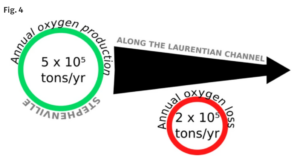
Comparison of the rate of dissolved oxygen loss in the bottom waters of the Lower St Lawrence Estuary and Gulf over the last decades (red circle) and the projected production rate of oxygen from the first proposed green hydrogen plant in Stephenville, NL (green circle) Image source: https://link.springer.com/article/10.1007/s11027-023-10094-1
Chemical Oceanographer Douglas W.R. Wallas, who firmly believes that this hydrogen production could work, said that “The amount of oxygen that will be produced as a byproduct of hydrogen generation through electrolysis of water is more than enough, we’ve calculated, to compensate for the annual decrease in oxygen that’s been going on now for some years”.

